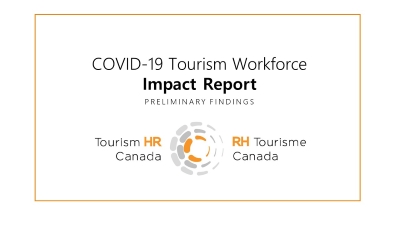Tourism has been severely limited since COVID-19 closed international borders. Statistics Canada’s tracking of travel to and from Canada showed that international travel came to a standstill by the end of March, with trips to Canada by travellers from abroad down 54.2% from February. International travel remained low in May, the latest month for which complete data is available, as arrivals from the United States were down 96.6% from May 2019 and arrivals from other countries were down 97.9%.[1] Leading indicators of cross-border travel and air arrivals for June indicate that little change in these trends should be expected this summer.
The impact on the tourism sector has been massive. The food services industry saw the value of sales decline from just under $6.3 billion in February to $2.3 billion in March before rebounding to $3.1 billion in May.[2] On average, the restaurant industry gets about 20% of its demand from tourists. The industry has capacity to rebound with increasing demand from locals, but social distancing requirements will limit demand due to reduced numbers of customers.
Industries that rely more on travellers face significant challenges. Hotel occupancy data available from STR shows that weekly occupancy dropped below 15.0% in April and had only recovered to 35.4% as of the week ending July 25.[3]
This data only shows the demand drivers on some industries within the tourism sector. Recreation facilities and museums are also struggling to reopen. Some have chosen not to open as it is a better financial choice to avoid the cost of opening when demand is so low. However, businesses with fixed costs related to rent and maintenance cannot as easily balance their operational costs.
Between June 10 and July 12, Tourism HR Canada fielded the COVID-19 Tourism Workforce Impact Survey and collected 605 responses from tourism operators across Canada. Responses were received from all provinces and the territories, as well as 28 responses from national businesses that were providing information for locations across provincial boundaries.
The survey was designed to measure the effect COVID-19 had had on tourism businesses’ operating status, their ability to operate this summer, their staffing needs, and other challenges, as well as their ability to access government supports such as the Canadian Emergency Wage Subsidy (CEWS) and the Regional Relief and Recovery Fund.
 The results show that only a fraction of tourism businesses are operating at full capacity. Many remain closed and many intend to remain closed this summer. Those that have reopened or expanded operations since the strictest COVID-19 containment measures were lifted are hiring back former staff, but employment is expected to remain well below the levels seen in 2019.
The results show that only a fraction of tourism businesses are operating at full capacity. Many remain closed and many intend to remain closed this summer. Those that have reopened or expanded operations since the strictest COVID-19 containment measures were lifted are hiring back former staff, but employment is expected to remain well below the levels seen in 2019.
Despite many people out of work, some businesses are still concerned they will be challenged to find workers this summer, and they also face challenges adapting to the new protocols and regulations they must abide by.
Most businesses are finding ways to adapt, however, and many are utilizing or plan to utilize available support programs such as the Canadian Emergency Wage subsidy. Over half of respondents had applied for coverage, with almost all being approved. A smaller number of respondents utilized the Regional Relief and Recovery Fund, due to a lack of awareness of the program or because they had already been able to access the Canadian Emergency Business Account.
Click here to explore the COVID-19 Tourism Workforce Impact Report (Preliminary Findings).
[1] Statistics Canada, Travel between Canada and other Countries, May 2020
[2] Statistics Canada, Food services and drinking places, May 2020
[3] STR, STR: Canada hotel results for week ending 25 July, https://str.com/press-release/str-canada-hotel-results-week-ending-25-july


